Author: BeLight.com
No one can escape from going to a hospital since the very first day we were given birth. Except for seeing doctors, undergoing surgeries and getting prescriptions, some patients have to stay in patient rooms for an extended period of time for further medical examination and better recovery. This is a space that should be as comfortable as your bedroom, but rarely are. BeLight is offering a review on this topic and share some news about lighting ideas for hospitals.
-

-
St. Joseph’s Regional Medical Center
Photo Credit: Traxon
Requirement
When it comes to hospital lighting, it’s not a matter of one size fits all. Generally speaking, a hospital is usually combination of entrance halls, offices, circulation rooms, waiting rooms, operating theaters, intensive cares and patient rooms. Some hospitals even have parks and corridors. As they all play different roles in a hospital, we cannot use only one solution for them all.
Philips Co. and Osram are companies which have been devoting efforts into lighting solutions and lighting case studies. Both of them have started developing innovative lighting concepts for healthcare lighting. In Philips’ brochure “Healthcare Application Guide,” it points out specialties for different spaces in hospitals and provides solutions suggested by experts. Here, we will take a look at several new and helpful ideas for patient rooms.
-
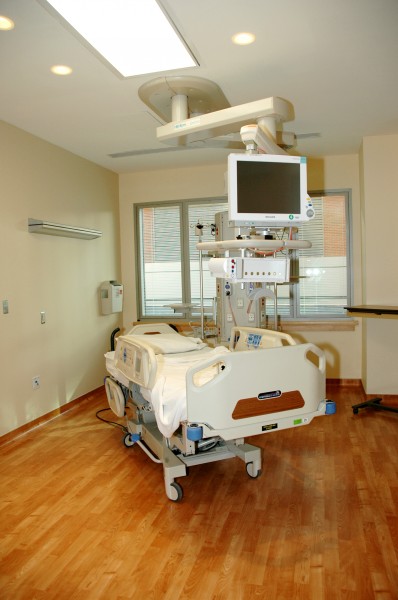
-
A single empty hospital bed in a patient room, located in the Clinical Research Center, National Institutes of Health (NIH), Bethesda, Md.
Photo Credit: Diane A. Reid (Common Wikimedia)
Patient rooms, including ICU, are spaces that are required to be bright enough for medical examinations, yet also need to be comfortable and calm for patients in order to rests for their recovery. However, most patient rooms look like cold, bright white boxes with scary medical appliances. It seems that there are only two luminance situations in patient rooms: during the day, bright; during the night, dark. Although we all know how important patient rooms are, no one would tell you that he/she feels “not bad” inside.
Projects
According to Philips, lighting for hospitals should emphasize on ambience, sustainability and well-being. For ambience, it is required to create a comfortable lighting condition to ease patients and their family’s nerve. For sustainability, this is an idea that follows the recent green trend. It is not a surprise that well-being is the most specific and important feature, and “feel better” is the central dogma of people who go to hospitals. Light profoundly affects our well-being, and our daily routine is almost defined by the regularity of the sun. In high-intensity 24/7 working environment like hospitals, adequate lighting can stimulate people’s motivation while make them calm down, and inadequate lighting, vise versa.
-
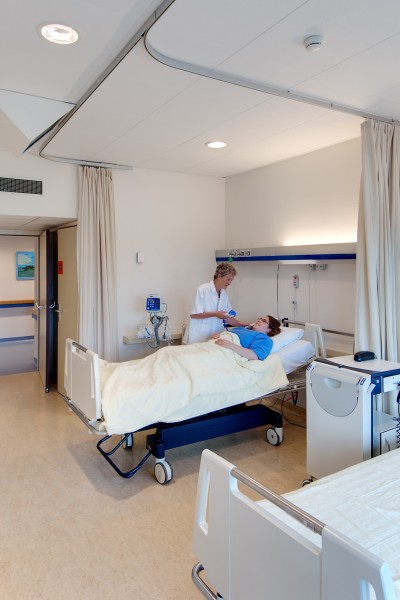
-
University Medical Center
Photo Credit: Philips Co.
Environment
A comfortable environment not only helps patients to recover but also improve the energy of the staff. A research conducted by Philips says that the beneficial effects brought about by adequate lighting in patient rooms include:
-
Improved patient and staff satisfaction
-
Longer sleep duration for patients
-
Shorter time to fall asleep for patients
-
Enhanced mood of patients, as derived from the HADS (Hospital Anxiety and Depression Scale) depression scores
Philips shows an example to explain their efforts on this issue:
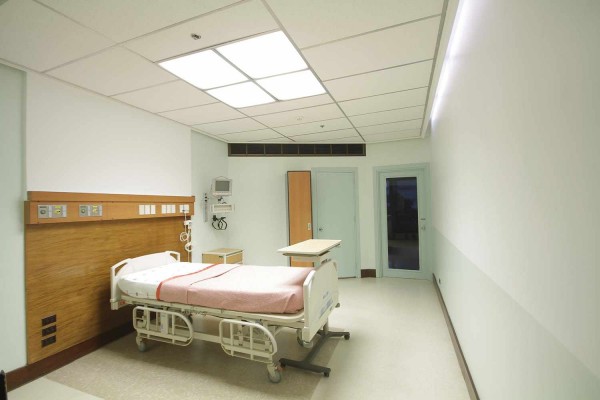

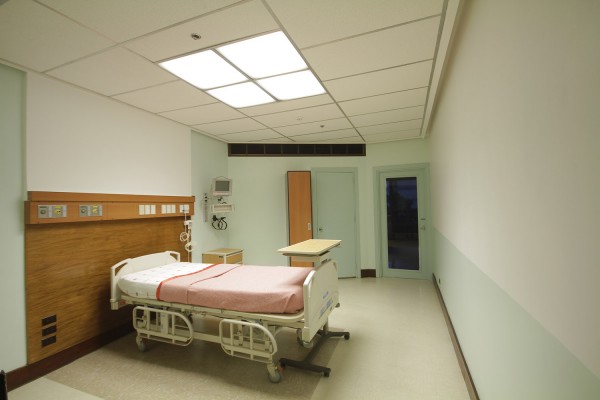
These three photos are taken in Philippines Heart Center’s ICU. Lighting designers who worked with Philips introduced the company’s new lighting solution “HealWell” which addresses the human body’s natural responses to light in patient rooms. This state of the art technology can simulate natural sunlight indoors, allowing patients to maintain their biorhythm and have an enhanced sense of comfort and well-being.
Ceiling and Wall
Aside from the atmosphere in patient rooms, the ceilings and walls are also key elements as they are something the patients stare at all the day. Both Philips and Osram started designing LED ceiling and warm-white walls for patient rooms which are also built in lighting control systems. The following is an example illustrating how adjustable ceiling could be a good way to change atmosphere in patient rooms: The Patient Room 2020 in New York, USA.
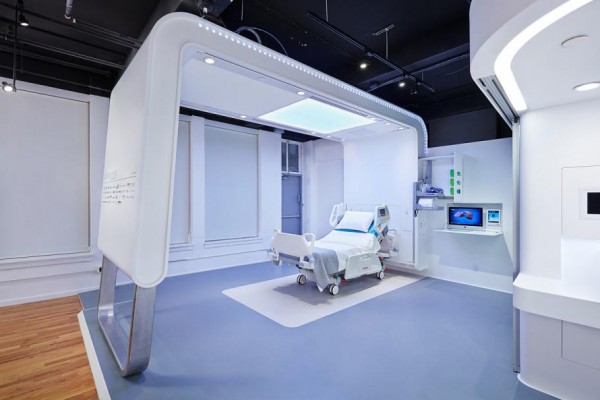

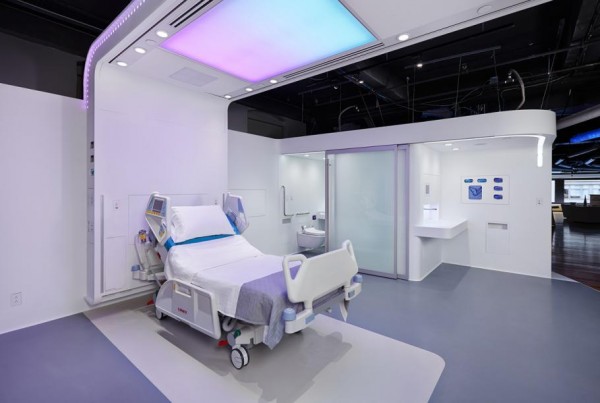
Another similar example is Philips’ new project to test how light color in patient rooms could affect people’s mind-body situations:Luminous ceiling from Philips simulates daylight to comfort critically ill patients in Intensive Care.
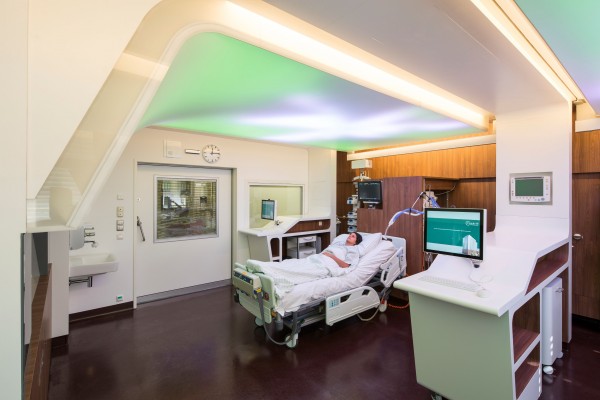
Both cases convey the same vision: if our health is closely connected with sunlight, creating artificial light to simulate dimming similar to real sunlight would be beneficial to us. Also, the colorful light may be more relaxing for patients, their families and hospital staff.
Vibrant Ambience
Once designed for children, luminous textiles are become more popular in hospitals. These textiles are usually made of LEDs in a panel shape so they can be installed on walls and ceilings to transform the cold, severe atmosphere in hospitals. Some luminous textiles are able to show a variety of dynamic lighting flows so the space would become more vibrant and warm.
-

-
Nemours Children’s Hospital
Photo Credit: Traxon
Future and Vision
Since it’s almost impossible to get rid of going to see doctors and visiting your friends or family members in hospitals, experts and researchers launch lots of lighting programs with manufacturers to improve people’s well-being.
From all these projects and cases, it is clear that a lighting condition which mimics the change in light similar to that in nature would become more and more important. Brightness is not the only rule every space in hospitals need to obey.
-

-
Kraamsuite AZM in Netherlands
Photo Credit: Philips Co.
























